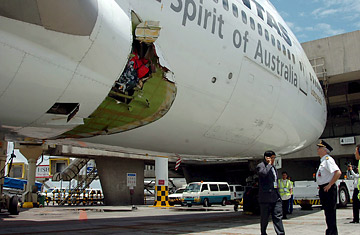
Pilot captain John Francis Bartels views the damage to a Qantas Airways Boeing plane following an emergency landing at Ninoy Aquino International Airport in Manila
Without question, the rapid decompression of the Qantas Boeing 747 that landed in Manila on July 25 was bizarre. Fortunately, large gashes do not often appear in passenger jets. When they do, they tend to happen where there is structural strain (like at door hatches), not in the forward cargo compartment, as in this case with Qantas. (The cause of the accident remains a mystery, and the U.S. is sending a team from the National Transportation Safety Board to assist in the investigation in the Philippines.)
But rapid decompressions, in general, are not unheard of — and, as the passengers from the Qantas plane now know, not necessarily as apocalyptic as they seem at the time.
What happens when your plane suddenly depressurizes? Any dramatic loss of pressure — caused by the sudden surge of outside air into the cabin — feels like you are going up a skyscraper in an elevator powered by a rocket. Your ears pop, and the pain can be intense. You may experience some temporary hearing problems, but nothing too serious in most cases.
At the same time, the plane will likely drop in altitude quite dramatically. But this sensation is actually good news, says Todd Curtis, an engineer and former airline safety analyst at Boeing. It usually means that the pilots are trying to get the plane low enough so that the outside air is breathable for humans. Says Curtis: "It may seem like the aircraft is going through a radical maneuver, and it is radical compared to normal flying, but this is standard protocol."
Meanwhile, the oxygen masks will probably drop from the ceiling. This, too, may look exceedingly ominous. But you won't die if you don't get a mask on, provided you were already generally healthy. "Passing out is about the worst thing that would happen," Curtis says.
There are only about 10 to 15 minutes of oxygen on those masks anyway, and they are provided just to help keep you comfortable until the plane reaches a lower altitude, where you can breathe easily and without assistance. The most important thing is that the pilots get their masks on first — and they have been trained to do this much faster than you will get yours on. That said, it is best to put your mask on before helping anyone else, since you only have a matter of seconds before you may lose consciousness.
As if there weren't enough going on, it is also quite common to see what looks like smoke in the air. But this is actually fog or mist that comes from the sudden change in pressure.
The flight can continue on in this surreal fashion for a while, with the oxygen masks dangling from the ceiling like so many IV lines, and passengers will usually remain relatively calm, as evidenced by video taken inside the Qantas flight. Decompression may be scary, but it is survivable.
Senior writer Amanda Ripley's new book The Unthinkable: Who Survives When Disaster Strikes — and Why, is about human behavior in catastrophes.
